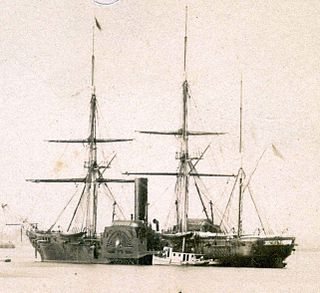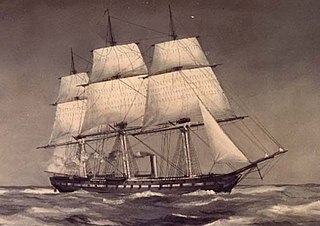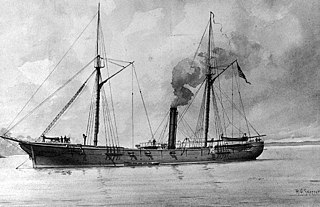
USS Advance, the second United States Navy ship to be so named, was later known as USS Frolic, and was originally the blockade runner Advance captured by the Union Navy during the latter part of the American Civil War. She was purchased by the Union Navy and outfitted as a gunboat and assigned to the blockade of the waterways of the Confederate States of America. She also served as dispatch ship and supply vessel when military action eventually slowed.

The third USS Chippewa was a Unadilla-class gunboat which saw service with the U.S. Navy during the American Civil War.

USS Susquehanna, a sidewheel steam frigate, was the first ship of the United States Navy to be named for the Susquehanna River, which rises in Lake Otsego in central New York and flows across Pennsylvania and the northeast corner of Maryland emptying into the Chesapeake Bay.

USS Wabash was a steam screw frigate of the United States Navy that served during the American Civil War. She was based on the same plans as Colorado. Post-war she continued to serve her country in European operations and eventually served as a barracks ship in Boston, Massachusetts, and was sold in 1912.

USS Tacony was a double-ended, side-wheel steamboat acquired by the Union Navy during the third year of the American Civil War. She was outfitted as a heavy gunboat with powerful guns and used in the Union blockade of the waterways of the Confederate States of America.

USS Stars and Stripes was a 407-ton steamer acquired by the U.S. Navy and put to use by the Union during the American Civil War.

USS Marblehead was a Unadilla-class gunboat built for the United States Navy during the American Civil War.

The first USS Monticello was a wooden screw-steamer in the Union Navy during the American Civil War. She was named for the home of Thomas Jefferson. She was briefly named Star in May 1861.

USS Commodore Hull was a ferryboat acquired by the Union Navy during the American Civil War. She was outfitted as a gunboat and assigned to the Union blockade of the Confederate States of America.

USS Ottawa was a Unadilla-class gunboat built for the Union Navy during the American Civil War. Her wooden hull was built by J. A. Westervelt, and her engines by the Novelty Iron Works of New York. She was commissioned at the New York Navy Yard on 7 October 1861.

USS Winona was a Unadilla-class gunboat built for service with the Union Navy during the American Civil War. Winona was heavily armed, with large guns for duels at sea, and 24-pounder howitzers for shore bombardment. Winona saw significant action in the Gulf of Mexico and in the waterways of the Mississippi River and was fortunate to return home safely after the war for decommissioning.

USS Unadilla was a Unadilla-class gunboat built for service with the United States Navy during the American Civil War. She was the lead ship in her class.

USS Huron was a Unadilla-class gunboat built for the United States Navy during the American Civil War for blockage duty against the ports and rivers of the Confederate States of America.

The first USS Pequot was a wooden screw gunboat of the Union Navy during the American Civil War. The ship was launched on 4 June 1863 by the Boston Navy Yard; and commissioned there on 15 January 1864, Lt. Comdr. Stephen P. Quackenbush in command. The ship was named for the Pequot Indian tribe resident in Southern Connecticut, members of the Algonquian language grouping.

USS Wissahickon was a Unadilla-class gunboat that was built for service with the United States Navy during the American Civil War.
USS Vixen was acquired by the Union Navy from the United States Coast Survey on 26 August 1861 for use as a reconnaissance vessel during the American Civil War; and was later commissioned on 31 July 1862.
USS Western World was a ship acquired by the Union Navy during the American Civil War. She was used by the Navy to patrol navigable waterways of the Confederacy to prevent the South from trading with other countries.
USS Britannia was a steamer captured by the Union Navy during the American Civil War. She was used by the Union Navy as a gunboat and patrol vessel in support of the Union Navy blockade of Confederate waterways.
USS State of Georgia was a large steamer with powerful guns acquired by the Union Navy during the American Civil War. State of Georgia, with her crew of 113 sailors and officers, was used by the Union Navy as a gunboat in its blockade of Confederate waterways.
USS Wyandotte, originally USS Western Port, was a steamer acquired by the Navy as a gunboat for the Paraguay expedition in 1858. When the crisis of the American Civil War occurred, she operated in support of the Union Navy blockade of Confederate waterways.

















